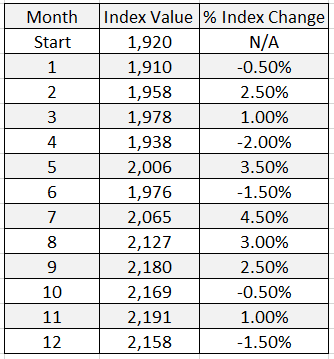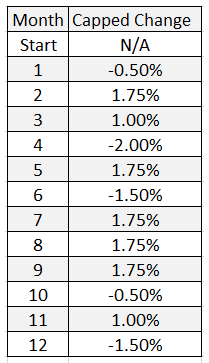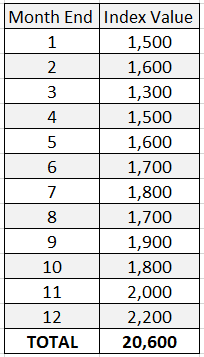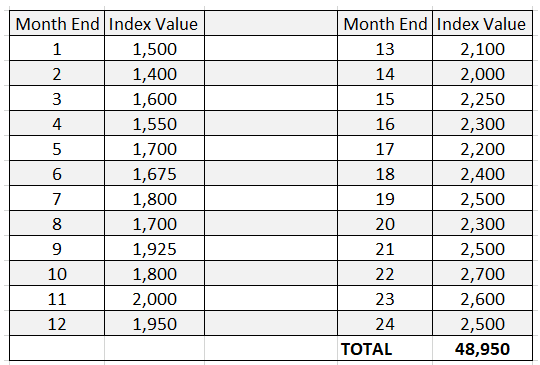How Annuity Indexing Works

Annuities come in all shapes and sizes. And when you are considering one as part of your retirement strategy, sure, it’s important to determine whether an annuity is right for your financial situation.
But there are more annuities than hedge funds in today’s financial marketplace. That is a staggering number of options. If, relative to other solutions, an annuity does help you achieve your retirement goals, then choosing the right one is just as important as its role in your portfolio.
When people plan for their retirement, they usually have one chance to get it right. Your choices will determine whether you live well in later years – or will fall short and will have to deal with the results. This applies just as much to annuity purchase decisions as well as other financial choices for your future.
If you happen to be considering a fixed index annuity for your retirement, understanding how the annuity indexing works is a crucial component.
Your index annuity has many ways of being credited interest. And you might also have a wide menu of index options, from the plain-vanilla S&P 500 price index to newly-minted “volatility controlled” indices.
First, let’s explore how annuity indexing works. This will cover only annuities of the fixed variety.
Then we will address the new wave of indexing options that include volatility controls, which are a debated topic in the industry.
What Affects the Amount You Can Earn?
Fixed index annuities (FIAs) earn interest based on formula tied to changes in specific indexes. Other fixed-type annuities earn fixed interest rates, which helps explain the “fixed” in their name.
Because of their ties to an index, fixed index annuities tend to have more slightly more growth potential than their fixed-annuity cousins. How frequently the crediting occurs in an FIA, and what interest is credited, depend on the terms and conditions of an FIA contract.
It’s important to understand how the insurance company tracks the index. It directly affects how much growth your money will see.
Here’s an important point to remember. When an index has losses in a certain period, the FIA will be credited 0%. This is due to the floor of protection that is built into fixed index annuity contracts.
Your principal, and the interest you have already earned, are protected from index losses. In exchange for this protection, however, you will be credited only a portion of the index value growth.
How Earned Interest Can Be Calculated
The amount you receive from the insurance company hinges on a variety of factors. A combination of these variables may affect a fixed index annuity’s growth potential:
Participation rates – a percentage of an index change that the insurance company applies to the annuity. For example, say the index shot up 10% and the FIA’s participation rate was 60%.
A rate of 6% would be credited to the fixed index annuity (0.6x 0.1=0.06).
Caps – a preset upper limit on how much interest can be earned in a certain timespan. Again, let’s say the index increased by 10% but the annuity had a cap of 5.5%.
In this case, the annuity would earn 5.5% for that period. Some fixed index annuities with participation rates also carry caps. Generally if an annuity has a 100% participation rate, it will have a cap of some sort.
On the other hand, those with a participation rate of less than 100% usually won’t have a cap limit. Be sure to confirm whether this applies to any fixed index annuities that you are discussing with your financial professional.
Spreads – also know as “asset fees” or as “margins.” This is a percentage-based fee that is subtracted from the index growth.
If the index went up 10% and the spread was 3.5%, the annuity would be credited 6.5% for that period. This is because 10%-3.5%=6.5%.
Floors – a minimum-level interest rate that an annuity can earn. This rate is particularly important when an index drops in value for a certain period. Most floors are set at 0%.
For example, say the index fell 10% — so it had a change of -10%. The annuity would simply be credited zero for that period. This floor of protection is one benefit you receive in exchange for some limits on the annuity’s growth potential.
Rider charges – riders are add-ons to annuities which can help solve for certain risks or bring additional benefits, such as a guarantee of a minimum lifetime income.
A rider may come with an additional fee, which may take away some from the amount you earn. Be sure to ask your financial professional about any rider fees that may be in an annuity you are exploring.
Premium bonuses – a percentage of the amount of premium money you put into an annuity that is credited to your annuity policy. For example, say an annuity has a premium bonus of 10% and you put $100,000 of premium in.
Your cash inside the annuity – formally called the “accumulation value” – would receive a $10,000 premium bonus, since $100,000 x 0.10 = $10,000. However, the premium bonus, and any additional earnings it receives, are likely to have vesting requirements that must be met so you receive the full bonus.
The vesting schedule for the bonus may last longer than the annuity’s surrender period. Be sure to check this in the annuities you are considering. If you surrender the annuity before the vesting schedule is up, you may have to pay back the premium bonus along with any potential surrender charges.
Insurer rate changes – insurance carriers have the flexibility to change participation rates, caps, or spreads. They can lower participation rates as well as increase caps or spreads.
If you choose to purchase a fixed index annuity, you likely may see these changes on the anniversary date of your policy. Your annuity can also see increased participation rates or lower caps or spreads.
Why do insurance companies have this ability? Bond yields, interest rates, market conditions, and overall economies change. These variables are beyond the control of the insurance company – and, for that matter, any one financial company.
These levers help the insurance company maintain its annuity promises to you – and to operate profitably.
Most Common Fixed Index Annuity Crediting Methods
With this said, knowing how insurance companies credit interest in the FIA will help you choose the right type of FIA for your requirements. Here are common crediting methods used by the insurance companies.
It’s important to note that, for all these methods, once any interest credits are added to your accumulation value, they are locked in and can’t be lost to index drops. This applies even if index values decline in future years.
Therefore, index credits for any crediting period can only be positive, or zero.
The index values, the interest calculations, and the interest rates used in the examples below are completely hypothetical and are intended to be educational in nature.
1-Year Annual Point-to-Point Cap Index
This strategy compares two points: The S&P500 Price Index value at the beginning of the contract year and the value at the end of that year.
Any percentage increase gets credited to the annuity’s accumulation value, subject to the annual cap rate, which is predefined as the “cap” on the interest you can be credited in one year.
Hypothetical Interest-Crediting Calculation Example
Starting Year Index Value: 1,775
Ending Year Index Value: 1,825
Current-Year Point-to-Point Cap: 5.0%
Interest-Crediting Calculation:
(1,825/1,775) – 1 = 2.82%
Interest Credited: 2.82%
While the cap can never be less than the guaranteed minimum cap rate, the insurance company has the discretion to reset the cap rate at the beginning of each contract year. But it can never be less than the guaranteed minimum cap rate.
Index credits for any crediting period can only be positive, or zero, but never negative. And once added to your accumulation value, index credits are locked in.
1-Year Point-to-Point Participation Rate Index
Just as above, this strategy compares the index’s starting-year value and its end-year value. The insurer credits interest to your accumulation value based on the change in the index value for the year.
Any point-to-point percentage increase is multiplied by the participation rate. The resulting amount is credited to your annuity’s accumulation value at the end of each year.
Hypothetical Interest-Crediting Calculation Example
Starting Year Index Value: 1,775
Ending Year Index Value: 1,925
Current-Year Point-to-Point Participation Rate: 50.0%
Interest-Crediting Calculation:
(1,925/1,775) – 1 = 8.45%
8.45% x 50.0% participation rate = 4.23%
Interest Credited: 4.23%
The participation rate may be reset at the start of a new year by the insurance company. But this can never be less than the guaranteed minimum participation rate.
The interest credited can be either positive or zero. And, as before, your principal and already-earned interest are locked in at the end of the crediting period.
1-Year Monthly Cap Index
Your annuity’s accumulation value is credited annually. This is based on the capped cumulative monthly changes in the S&P 500 Index for your contract year.
When the index records a positive change for the month, the monthly cap rate limits that growth.
When the index records a negative change for the month, there is no floor or cap on that decline. The date of your contract anniversary is the date the index value is recorded for each month.
At the time of your contract’s anniversary date, those recorded monthly percentage changes (adjusted for the monthly cap when positive) are added together to determine the credit to your annuity’s accumulation value.
Hypothetical Interest-Crediting Calculation Example
Starting Year Index Value: 1,920
Current-Year Month Cap: 1.75%
Step 1: Gather Monthly Index Changes

Step 2: Apply Cap Rate to Index Values

Step 3: Add Up These Adjusted Monthly Values for Cumulative Total

Interest Credited: 4.75% – cumulative total
1-Year Monthly Average Cap Index
The average of the monthly values of the S&P500 Index for your contract year is compared to the index value at the beginning of the contract year.
Your contract anniversary date is the date each monthly index value is taken. When the average of these monthly values is greater than the beginning index value, the percentage change is credited to your annuity’s accumulation value, subject to an annual cap.
Hypothetical Interest-Crediting Calculation Example
Starting Year Index Value: 1,500
Current-Year Month Cap: 6.0%

Interest-Crediting Calculation:
20,600/12 = 1,717
(1,717/1,500) – 1 = 14.47%
Cap Rate of 6% applied = 6.0%
Interest Credited: 6.0%
2-Year Monthly Average Cap Index
This crediting method is similar to the Monthly Average Cap Index, but lasts for 24 months instead.
Just as above, when the average of these monthly values is greater than the beginning index value, the percentage change is credited to your accumulation value. It is subject to a biennial cap.
Hypothetical Interest-Crediting Calculation Example
Starting Year Index Value: 1,500
Current-Year Month Cap: 10.0%

Interest-Crediting Calculation:
48,950/24 = 2,040
(2,040/1,500) – 1 = 36.0%
Cap Rate of 10% applied = 10.0%
Interest Credited: 10.0%
Volatility-Controlled Indexing Strategies
Now, a few words on volatility-controlled indexing strategies.
Wink, a competitive intelligence and market research firm for the life insurance and annuity industries, questioned why annuities needed volatility-controlled strategies. After all, fixed index annuities, by design, are volatility-controlled.
“The worst indexed interest rate a consumer can receive is ZERO. By its very nature, a Fixed Index Annuity is designed so a consumer won’t lose money when the market index that their interest rate is linked to is negative. This is the ultimate in volatility control,” according to a post on their website.
Volatility-controlled indices were introduced into the fixed index annuity market in 2013. Within five years, there were 78 indexing options that included volatility controls, according to Wink, Inc.
The concern? That many of these unconventional indexes haven’t been around long enough to provide a true track record.
What Are Some Potential Pitfalls?
These options are often explained via detailed performance illustrations that give two perceptions:
1) the impression of a long-proven record for interest crediting, and;
2) on paper, a seemingly credible history of these indexes for consumers to form expectations about how much interest a FIA can earn each year.
The issue? Illustrations are often far different from how FIAs perform.
An FIA should be chosen on the strength of its actual guarantees and what you are assured contractually. Buying into growth projections that may not materialize could prove to be troublesome some time down the road.
This isn’t to say that volatility-controlled indexes don’t have a place in the market. It’s just that many of them have been around for less than 10 years. And having worked for many years, you now need solutions that help you solve problems, not that might create new ones.
Discuss these options carefully with your financial professional, if an annuity you are looking at includes such index choices.
Finding a Fixed Index Annuity for You
So, the final takeaway? An FIA needs to have a clear role in your retirement strategy.
It should have a well-defined purpose for solving potential issues that other products in your portfolio aren’t shoring up.
Do you need lifetime income for living expenses? Are you seeking principal protection while having conservative growth potential? Both are hallmarks of the fixed index annuity.
Roger Ibbotson, a highly respected authority on investing, defines a fixed index annuity as a tax-deferred retirement savings vehicle that “eliminates downside risk while allowing for the opportunity to participate in upside market returns.”
Once you have a diagnosed need in your portfolio and for your financial strategy, you are prepared to search for the FIA that is right for you. And to help you in this search, consider working with a knowledgeable financial professional. They can be a tremendous asset in helping you locate a fitting solution.
Ready for Personal Guidance?
Financial professionals at SafeMoney.com are ready to assist you. They can be contacted easily and are just a click away.
Use our “Find a Financial Professional” section to connect with someone directly. You can request an initial appointment to discuss your retirement and income goals. Should you need a personal referral, call us at 877.476.9723.








